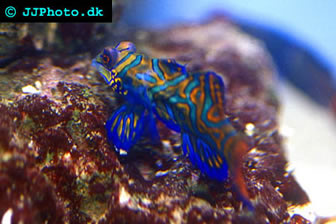Dragonets
Dragonets are found in the family Callionymidae in the order Perciformes. Fishbase currently lists 130 species divided into 18 different genera. Dragonets are sometimes referred to as gobies, but they are not true gobies since they do not belong to the family Gobiidae.
Dragonets in the aquarium
Many dragonets are strikingly coloured and several species have been successfully kept by aquarists. Two of the most commonly found species in the aquarium trade are Mandarin dragonet (Synchiropus splendidus, formerly known as Pterosynchiropus splendidus) and Ocellated dragonet (Synchiropus ocellatus). Both are commonly kept in reef aquariums since they do not disturb or injure corals. They should ideally not be kept in aquariums without significant amounts of live rock.
Most dragonets are specialized and finicky eaters that will only eat live food in the aquarium. Many dragonets have starved to death rather than accept dead food. It is therefore best to keep dragonets in large aquariums (at least 55 gallons / 200 litres) inhabited by large and thriving populations of amphipods and copepods. You can also try to feed your dragonets live brine shrimp and mysis shrimp, but they might not eat it.
Geographical range, habitat and habits
Dragonets are mainly found in the tropical waters of the Indo-West Pacific. They are benthic creatures, i.e. they spend most of their time on or near the bottom. Dragonets have been found down to a dept of roughly 200 meters (650 feet) and prefer rocky or sandy bottoms. Some species occur near coral reefs.
Male dragonets are highly territorial towards each other.
Feeding Dragonets
Dragonest feed on small invertebrates, such as worms and crustaceans, which they find on or in the substrate at the bottom of the sea. A bulk of their diet consists of copepods and amphipods.
Breeding Dragonets
During the breeding period the male fish will court the female by showing off his flashy fins and open and close his mouth over and over again. If he manages to impress a female ready for breeding, they will form a pair and swim upwards towards the surface. The male will support his partner on his pectoral fins and eggs and sperm will be released in midwater.
Dragonets are pelagic spawners and they do not guard their offspring. The female releases a high number of eggs each spawning and since they are buoyant they will intermingle with the plankton of the ocean and be swept away by current.
Appearance
Dragonets are often decorated with a cryptic pattern consisting of vibrant colours. Some species are even referred to as “psychedelic fish”. All the fins are large and showy and the tailfin is fan-shaped and tapered. The dorsal fin is high and usually equipped with four spines. In male fish, some of the spines can be embellished with filamentous extensions. The body of the fish is elongated and the preopercle is protected by a strong spine. The head of a dragonet is flat and triangular with big eyes and a large mouth.
The largest known species of dragonet is the Longtail dragonet (Callionymus gardineri) which can become 30 cm (1 foot) long. The smallest known dragonet is the tiny St. Helena dragonet (Callionymus sanctaehelenae) which rarely exceeds 2 cm (0.8 inches) in length.
Dargonet articles
Green Mandarinfish – Guide to keeping Synchiropus spendidus
Spotted Mandarinfish – Guide to keeping Synchiropus picturatus
Starry Dragonet – Guide to keeping Synchiropus stellatus
Anthias
Aquarium Chillers
Basses
Batfish
Blennies
Butterflyfish
Cardinalfish
Clown fish
Corals
Damselfish
Files
Goatfish
Gobies
Gorgonians
Grammas
Groupers
Grunts
Hawkfish
Jawfish
Jellyfish
Lionfish
Dragonets
Mantis shrimp
Marine angelfish
Marine Catfish
Moray eels
Nudibranch
Octopus
Pipefish
Protein skimmers
Pufferfish
Rabbitfish
Rays
Snappers
Scorpionfish
Sea Anemones
Sea horses
Sea Stars
Shark Fish
Shrimps
Snails
Squirellfish
Surgeonfish
Triggerfish
Wrasses

